| Article ID | Journal | Published Year | Pages | File Type |
|---|---|---|---|---|
| 2093650 | Stem Cell Reports | 2015 | 15 Pages |
•BMP induces WNT-dependent and -independent differentiation pathways in hESCs•Modulating WNT and BMP directs differentiation toward mesoderm or trophoblast•WNT inhibition returns epiblast stem cells to a chimera-competent pregastrula state•WNT inhibition prevents spontaneous differentiation of hESCs and epiblast stem cells
SummaryTherapeutic application of human embryonic stem cells (hESCs) requires precise control over their differentiation. However, spontaneous differentiation is prevalent, and growth factors induce multiple cell types; e.g., the mesoderm inducer BMP4 generates both mesoderm and trophoblast. Here we identify endogenous WNT signals as BMP targets that are required and sufficient for mesoderm induction, while trophoblast induction is WNT independent, enabling the exclusive differentiation toward either lineage. Furthermore, endogenous WNT signals induce loss of pluripotency in hESCs and their murine counterparts, epiblast stem cells (EpiSCs). WNT inhibition obviates the need to manually remove differentiated cells to maintain cultures and improves the efficiency of directed differentiation. In EpiSCs, WNT inhibition stabilizes a pregastrula epiblast state with novel characteristics, including the ability to contribute to blastocyst chimeras. Our findings show that endogenous WNT signals function as hidden mediators of growth factor-induced differentiation and play critical roles in the self-renewal of hESCs and EpiSCs.
Graphical AbstractFigure optionsDownload full-size imageDownload as PowerPoint slide
